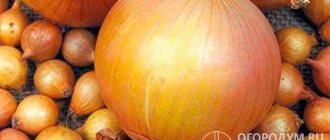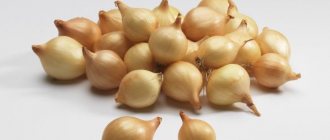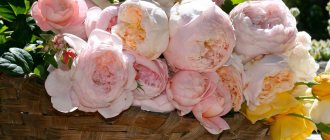English roses are a relatively recently developed rose species. Appeared through crossing varieties such as “Dainty Maid” and “Belle Isis”. The result was a new group of varieties.
Which has absorbed the best qualities of both sides, acquiring a lush flower, a wonderful aroma and resistance to virtually all diseases. It is also worth noting that it is more resistant to harsh climates than its ancestors.
Pros and cons of English roses
Species obtained by crossing others, that is, artificially bred, often have excellent qualities. This is exactly the situation with David Austin varieties, named after their creator, an English breeder.
Advantages
These roses have a very strong, pleasant aroma, their flower shape is more advantageous than that of their counterparts. It is highly resistant to climatic conditions, be it harsh winters or hot summers. In addition, flowers are formed along the entire stem, unlike other species.
Flaws
They are few in number and are easily compensated by the advantages. When the question of choosing a landing site arises, preference should be given to a place with partial shade. This is due to the fact that this species does not respond well to direct sunlight, but tolerates hot temperatures well. A dubious drawback is the high growth of the flower. Doubtful because for creating your own garden this is rather a plus, but for apartment conditions this is already a matter of planning.
Combination with other colors
English roses require a distance between bushes of at least 2-3 meters. Very often, plants are used for flower beds and garden decorations; they combine well with other types of flowers and are not difficult to care for.
This type of rose is popularly called ostinka; flowers are used to decorate gardens and parks. The plant does not require care, but can cause problems if you do not fertilize and water the plantings in a timely manner. The rose blooms throughout the summer and is pleasing in appearance.
How to choose the right seedling
When planting any plants, it is important to consider the climate for which they are intended and where they are intended to be grown. Austin's species was bred in the foggy and damp lands of England. Therefore, these conditions will be preferable for them. Of the approximately 200 varieties of roses in England, at least a third can live in the climatic conditions of our country.
How to choose the right variety for the climate of the territorial location of the site? You can take Canada as an example. Their climatic conditions are almost the same as Russian ones. Consequently, we can successfully maintain the varieties that they grow.
When choosing a seller, special attention should be paid to his competence in matters relating to English varieties. The fact is that scammers know how valuable seeds of this species are; they buy similar ones for a low price and sell them for much more. Naturally, preference should be given to nurseries where this beautiful flower is professionally bred. The price is a little higher, but this is because the sellers there give a guarantee of climate suitability. It is not worth buying seedlings at retail outlets located near roads. With almost 100% probability they are affected by diseases, or they may not be the variety that the buyer paid for.
Types and varieties of Austin roses
This artificially bred species is one of the few that has not yet been classified. However, experts have determined the exact groups into which it is divided.
Tall
They are distinguished by their large stem height, about 180 cm. For example, the Princess Margaret Crown variety. The shape of the buds is in the form of a bowl. The color is also far from the standards; they have a yellowish-orange color. The aroma is quite subtle, the presence of the smell of fruit is felt.
In terms of diseases, tall varieties are resistant to fungi and most standard diseases of such plants.
Some varieties, for example, Gertrude Jekyll, can easily reach 2 m in height and have a rosette flower shape. The smell is specific, but pleasant. Reminds me of rose oil. The color is beautiful, pink. It also has average resistance to plant diseases. This type is excellent for growing on site, the embodiment of a hedge plan.
For growing in containers
The Anna Boleyn variety belongs to this division. The shape of the flower is rosette, in the form of glasses. The color is soft pink, thinning out the delicate aroma. Great for people who cannot tolerate strong, strong odors.
Some varieties resemble rose hips, such as Christopher Marlowe. Endowed with a scent similar to rose oil. A distinctive feature is its strong resistance to climatic conditions and sudden changes in weather conditions.
Grace, a beautiful variety with apricot-shaped, dahlia-shaped flowers. Like its fellow species, it has the smell of oil.
Large glasses
The varieties included in this group are distinguished by their particularly large flower size, which is already clear from the name. They have a rich, delicate pink color. The aroma contains notes of raspberry, which itself is barely perceptible. They perform well in difficult weather conditions, demonstrating a high level of adaptation to the environment. However, there are varieties that are highly susceptible to low temperatures. These include Gentle Constance Spray. The light pink color will not leave anyone indifferent to its flowers.
There are even varieties that can change their smell depending on the weather. One of them is Princess Alexandra of Kent. The deep pink color and rosehip appearance go well together. The smell changes depending on the time of flowering, first you can feel tea notes, and then a fruity aroma.
Rose Abraham Derby is long-blooming with large peach-colored buds. Winter-hardy, disease resistant. But wilted flowers do not fall off, but rot on the bush, so timely pruning is necessary.
Variety Pat Austin - copper-orange with a tint, buds reach 12 cm, has a bright aroma of tea rose. Garter required. The stems cannot withstand the weight of the flowers.
Prince - Begins to bloom in a dark red shade that then turns purple. The height of the bush is 60-75 cm, the buds are about 8 cm.
The peculiarity of this group is that in order to grow and achieve the declared size, you need at least a couple of years of stable and proper care, observing all the nuances. Otherwise, they may not reach their full potential, or simply wither.
Pure colors
From the name it is clear that the color of the petals of such varieties does not even have a hint of a gradient or inclusions. Among them there are white, red roses, a large number of yellow tones, even orange.
Most popular:
- Graham Thomas - has cup-shaped glasses of a bright yellow color. At the same time, they exude a delicate scent of rose oil. The flowers are located close to each other.
- Claire Austin is a beautiful, clean white shade that feels like a canvas. It has a musky odor and average resistance to possible types of climate.
Varieties
The most popular varieties of David Austin roses have the following names :
- Benjamin Britten is a low bush that is easy to care for and resists powdery mildew well. The petals of this plant often have red or orange hues.
- William Shakespeare 2000 - this rose grows as an upright bush. The flowers are dark red in color. This variety is distinguished by its long flowering.
- Abraham Derby - Its color range ranges from copper to apricot tones. The weight of the flower head can be large, so slight deformation is possible.
- Graham Thomas is a plant that has bright yellow flowers and long flowering.
- Charlotte - this rose is distinguished by its double yellow flowers. This variety tolerates cold well.
- William Maurice is a plant that has rosette-like flowers in peach and pink colors. Closer to the center of the bud the color is more saturated, and on the outside it may be white. The flower resists spotting and powdery mildew well, as it tolerates high humidity and long rains.
Features of planting English roses
There are also many nuances in matters of disembarkation. The species was bred in climates where there is predominantly twilight. Accordingly, in order to provide comfortable conditions for the flower, it is necessary to select a shady place, or, in extreme cases, create such a place artificially.
English roses do not respond well to direct sunlight; for stable growth, they only need no more than 4 hours in a sunny place every day. In order to control the growth of the bush's stem, you can choose a brighter place than twilight. Thus, the stem will grow more slowly, at some point the growth will stop. This method is the simplest; it does not require special conditions or fertilizer.
They do not like the wind, so the growing area should be artificially protected from this weather feature. Or initially choose a windless place. For better growth, it is recommended to plant on a hill, preferably on a hill.
The area where such roses are supposed to be located must be prepared in a special way.
First, the seedlings are soaked in water, where growth-stimulating substances must first be dissolved. Sort of “flower anabolics”. Then a place is selected based on all the nuances of shade, wind, and preference for elevation.
English species and varieties of roses do not tolerate spring melt water at all. In winter, it is necessary to prevent snow from getting into the areas where these plants grow. The best option would be to choose a place near which there is a gazebo, or some other structure with a roof. It should be located in such a way that the shadow cast from the roof completely covers the flowers.
The pits for planting are being prepared. They must also have specific requirements. You need to dig a square, to the sides and 0.5 m deep. Then, you need to pour exactly 10 liters of water into each hole and leave them in this state for a day. This is done because roses love moist soil.
After directly planting the plants in the field, they must be moistened, spending at least 45 liters of water per bush. After this procedure, the soil begins to hill up. In England, where this species was bred, there is no snowfall as such, and in general snow is a rare phenomenon (at least in the form in which residents of Russia are accustomed to seeing it). Therefore, on the eve of the winter period, the question arises about preparing winter shelters for roses. The shelter is removed only in the spring, from the moment the temperature reaches 0 °C.
Such fastidious plants also need feeding. However, fertilizers should not be applied immediately after planting. They begin to be used only in the 2nd year of growing individuals. The first course is nitrogen, it serves as an impetus for the formation of young stems. The following contain a considerable amount of nitrogenous substances, even phosphorus. It is used during the active phase of bud formation.
Roses need to be pruned only once a year, in spring or autumn. During this procedure, it is necessary to remove dry and weak branches, further forming the shape of the bush.
An important feature is that in order to achieve maximum growth from the variety, at least half of the shoots are removed.
Caring for English roses
As for care, a specific approach is also required here.
As soon as the first shoots have formed, the soil near the base of the bushes is raked out, the soil is loosened, and then covered with sawdust. You can make a powder from pine needles and straw, this is done to better retain moisture in the soil.
Bush formation
Pruning is a must. It must begin immediately after disembarkation. The second time before wintering. Then, in the spring, before the buds open, the shoots are shortened to half their height. If you cut it into a third part. the bush will acquire a large number of buds, which will weaken the plant.
Immediately after the stem has grown stronger, almost all the shoots are removed, leaving only about 4 pieces.
It is important to understand that each variety requires an individual approach. For example, for climbing varieties, only 5 parts of the stem length are cut off.
Buds that have faded, as well as roses that are ripe, must be removed without delay. This will allow new buds to form as quickly as possible.
It is recommended to prune bushes that are more than one and a half years old in mid-spring. Just before the buds begin to bloom. If you are late, the roses will bloom much later. You should not stand on ceremony with weak and broken shoots, especially with sick ones, this is a matter of the health of the entire bush. Old ones are removed much less frequently, once every five years, and new growth forms in their place.
As for the tool used to perform bush pruning operations, it must be impeccably sharpened. This is necessary so that the cut is even and clear, otherwise the tool will simply break the plant.
Another feature of the cuts is that they must be made exclusively at an angle, at a strict distance of 5 mm from the nearest bud. The cut site must be immediately treated with a specialized garden solution or disinfectant.
Watering
Moistening is carried out only as it dries; there are no specific instructions or frameworks in this matter. Different varieties require different amounts of water. Climbing varieties require at least 15 liters, while regular varieties require only 10 liters. It is recommended to perform it in the evening. In matters of water, there are also wishes regarding its type. It is not suitable from the tap as it contains a large amount of chlorine. It is best to use settled melt or rain water.
If you overdo it with moisturizing the leaves, you can provoke the appearance of diseases. It is also impossible to water frequently in small volumes. You need to stop watering the bushes at the end of August, but if the summer is rainy, then much earlier. Next comes autumn, where the rainy season will provide the necessary level of moisture in the soil.
Winter shelter technology
As already mentioned, snow falling on the soil, and consequently its severe freezing (temperature below -10 °C), is unacceptable for varieties of English roses. In order to prevent this, it is necessary to construct special buildings that allow plants to wait out the inclement and cold seasons.
First comes the preparation stage for insulation. It consists of allowing the buds to bloom on their own, shedding their petals. If picked early, full ripening will be interrupted. During cold weather, the remaining leaves on the stem must be removed, and the side stems that have already matured must also be cut out. Only after a number of these measures can you begin to insulate.
Hilling comes first, after which the process of creating a winter shelter begins. To do this, you need to stretch some kind of mesh around the flowers; if there is none, plywood will do. The resulting open bunker is filled with dried leaves, then shavings, followed by humus. Climbing varieties are laid on top, secured and covered with a thick layer of dry leaves (at least 30 cm). Then, a film is pulled over the shelter from above. The shelter is disassembled only with the onset of spring, at a temperature not lower than 0°C.
Reproduction methods
This process occurs in the same way as in other types of roses. Cuttings, layering, suckers, all these methods are excellent for varieties of English roses. However, each method has its own advantages and disadvantages; they must be taken into account if the possibility arises of growing roses yourself, without outside help. Experts recommend using vaccination for propagation; this is the most effective.
Reproduction
The culture has a large number of reproduction methods. The cutting method is most often used; other methods are chosen by the gardener.
Vaccination
To apply this reproduction method, you must perform the following algorithm:
- choose a strong shoot without a bud;
- using a stationery knife, cut off the bud so that a piece of the shoot remains;
- it is necessary to clean the area of the neck of the bush and disinfect the grafting site with alcohol;
- make an incision and insert a kidney;
- carefully wrap with plastic tape or a bag;
- sprinkle with soil and leave until next season.
In spring, the grafting site is freed from the film, and the formation of a new rose shoot can be seen. The shoot is carefully dug up and planted in the soil.
By cuttings
After the bud fades, it is necessary to cut off the shoot and remove all leaves except the top two. The shoot is placed in a growth activator for 2-3 hours. After which the cutting is placed in the ground and covered with a glass jar.
Watering is carried out once every 2-3 days. The cuttings are left for the winter, in the spring you can see the appearance of the root and transplant the plant to places of constant growth. Special containers for seedlings can be used, and the cuttings are placed on the windowsill, previously covered with a jar or plastic bottle.
By layering
This method is often used for climbing varieties of roses. For propagation, it is necessary to lower the lower shoot to the soil and make an incision. Sprinkle the cut area with soil and leave until the next season for rooting. After the shoots appear, the sprout is carefully separated from the mother plant and placed in the ground.
Offspring
To propagate in this way, you need to take part of the plant root and place it in the soil, after moistening the hole. This method is often used for the spring replanting period.
Diseases and pests of Austin roses
With strict adherence to all the nuances of growing, watering and feeding, roses can grow for more than 20 years. However, despite all the efforts of the gardener, the situation can be significantly spoiled by pests and diseases. These include fungal ones; they mainly affect plant bushes. This is caused by improper wintering conditions for flowers. The syndromes develop on the stems; even on dead, fallen leaves, the gray color of the fungi persists for a long time. Spread is possible through a tool used to trim an infected specimen.
To prevent the occurrence of diseases, and as a result to avoid the death of plants, you must follow the list of rules:
- Plant only at a distance of at least 50 cm from each other, otherwise roses affected by the disease will easily infect others.
- Spray the leaves strictly in dry weather.
- After trimming, the removed parts must be burned and the instrument must be disinfected. The first sign of disease is spots on the bushes and a white coating. If symptoms are detected, it is recommended to treat immediately. For such purposes, 1% Bordeaux mixture every 5 days is suitable.
Mr. Summer Resident recommends: English roses in the landscape
This type of roses looks very beautiful and presentable. In general, any rose looks aesthetically pleasing, but the English ones have absorbed the best qualities.
The most commonly used varieties for decoration include:
Golden Celebration
The flowers are large and yellow in color. They have a pleasant, delicate smell. The height of the bush is average, no more than 150 cm. It belongs to the fast-growing, spreading type. The advantages include high disease resistance and repeated flowering.
William Shakespeare 2000
The first presentation of the rose dates back to 1987, but the variety turned out to be very painful, so 13 years later David Austin presented a more improved hybrid, characterized by increased resistance to all types of diseases. This variety attracts with large, dense flowers (one flower can have up to 120 petals) of a velvety red, very bright shade, which gradually turns into a rich purple over time. At the beginning of flowering, the flowers are deeply cupped, but then, gradually opening, they transform into more squared and flat ones. A large cluster of flowers is formed on each shoot; flowering can last up to two weeks. The bush is erect, vigorous, fast-growing, abundantly branched, heavily leafy. Leaves – large, pure green, matte
The William Shakespeare 2000 variety is named after Shakespeare, according to the results of a survey chosen by the person of the millennium. The bush is erect, branched, up to 120 cm high, 90 cm wide. The flowers are dark red with a purple tint, densely double, with a strong aroma. Flowering is continuous. According to David Austin himself, this is the best red English rose to date.
Garden composition of William Shakespeare 2000 and Prosperity roses against a background of cypress trees











